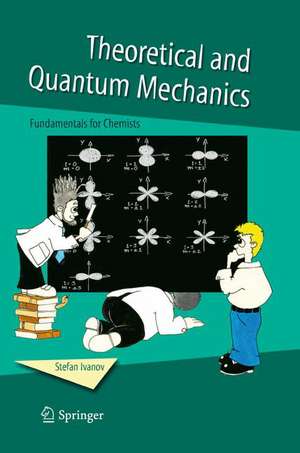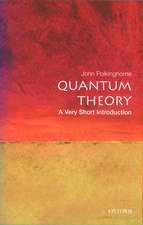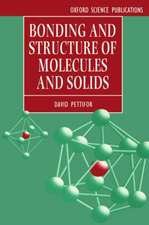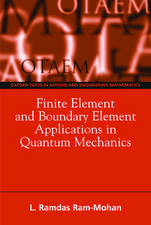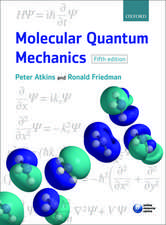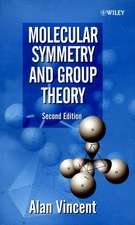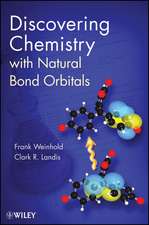Theoretical and Quantum Mechanics: Fundamentals for Chemists
Autor Stefan Ivanoven Limba Engleză Hardback – 15 noi 2005
Toate formatele și edițiile
| Toate formatele și edițiile | Preț | Express |
|---|---|---|
| Paperback (1) | 652.31 lei 6-8 săpt. | |
| SPRINGER NETHERLANDS – 23 aug 2016 | 652.31 lei 6-8 săpt. | |
| Hardback (1) | 658.70 lei 6-8 săpt. | |
| SPRINGER NETHERLANDS – 15 noi 2005 | 658.70 lei 6-8 săpt. |
Preț: 658.70 lei
Preț vechi: 774.94 lei
-15% Nou
Puncte Express: 988
Preț estimativ în valută:
126.04€ • 131.60$ • 104.32£
126.04€ • 131.60$ • 104.32£
Carte tipărită la comandă
Livrare economică 05-19 aprilie
Preluare comenzi: 021 569.72.76
Specificații
ISBN-13: 9781402033650
ISBN-10: 1402033656
Pagini: 514
Ilustrații: XXIV, 513 p.
Dimensiuni: 155 x 235 x 30 mm
Greutate: 0.93 kg
Ediția:2006
Editura: SPRINGER NETHERLANDS
Colecția Springer
Locul publicării:Dordrecht, Netherlands
ISBN-10: 1402033656
Pagini: 514
Ilustrații: XXIV, 513 p.
Dimensiuni: 155 x 235 x 30 mm
Greutate: 0.93 kg
Ediția:2006
Editura: SPRINGER NETHERLANDS
Colecția Springer
Locul publicării:Dordrecht, Netherlands
Public țintă
ResearchCuprins
Selected Topics of Theoretical Mechanics.- Lagrangian Function and Lagrange’s Equations.- Conservation Laws.- Central Conservative Forces.- Rotating Motion of a Charged Particle.- Small Harmonic Oscillations.- Hamiltonian Mechanics.- Basics of Quantum Mechanics.- The Sources of the Quantum Mechanics.- Old Quantum Mechanics.- The Wave Function.- Operators.- The Schroedinger Equation and Time Dependence of the Observables.- Motion in One-Dimensional Potential.- The Harmonic Quantum Oscillator.- The Two-Body Problem - a Hydrogen Atom and a Diatomic Molecule.- Perturbation Theory and Stark Effect.- Spin.- Interaction of an Electron in an Atom with Magnetic Field.- The Helium Atom.- Periodic Table.
Recenzii
"I like the approach followed very much. [...] He shows clearly that these more advanced and powerful methods can be straightforwardly applied to these problems. His transparant and elegant way of presentation will bring a deeper and more bountiful insight to the student in classical and quantum mechanics[...]"
(Steven Stolte, Department of Chemistry, Vrije Universiteit, The Netherlands)
"[...]I think it is a very useful book to have on my bookshelves, especially since it makes a clear connection between classical and quantum mechanics. [...]it is very useful for me and theoretically oriented chemists [...]I found the book very useful in preparing my lectures for my first-year quantum chemistry course as it gave me more insight into the connection between quantum and classical mechanics."
(Joop van Lenthe, Theoretical Chemistry Group, Utrecht University, The Netherlands)
(Steven Stolte, Department of Chemistry, Vrije Universiteit, The Netherlands)
"[...]I think it is a very useful book to have on my bookshelves, especially since it makes a clear connection between classical and quantum mechanics. [...]it is very useful for me and theoretically oriented chemists [...]I found the book very useful in preparing my lectures for my first-year quantum chemistry course as it gave me more insight into the connection between quantum and classical mechanics."
(Joop van Lenthe, Theoretical Chemistry Group, Utrecht University, The Netherlands)
Textul de pe ultima copertă
Theoretical and Quantum Mechanics: Fundamentals provides an introduction to theoretical and quantum mechanics for chemists. The book includes carefully selected quantum mechanics topics of the most fundamental interest and use for chemists and classical mechanics topics that relate and illuminate these. A comprehensive treatment is given wherever possible. The book acquaints the chemists with the quantum structure of the basic object of chemistry – the atom – and the author bridges the gap between classical physics, general and inorganic chemistry, and quantum mechanics.
The book provides the basics of theoretical and quantum mechanics in one place and emphasizes the continuity between them. Key topics include:
applications of quantum methods to simple systems, e.g. one-dimensional potential, harmonic oscillator, hydrogen atom, hydrogen-like atoms.
introduction of representation theory and elements of matrix mechanics
development of the perturbation theory
physical explanation of the interaction of an electron with magnetic field
generalization to many-particles systems.
Each chapter includes a detailed outline, a summary, self-assessment questions for which answers are in the text, a varied set of problems. In addition, the book contains many summary tables to ensure clarity of the subject.
This book will be invaluable for chemistry undergraduate and graduate students, chemists, other non-physical scientists, engineering students of modern techniques and technology, specialists who need a better understanding of quantum mechanics. The book is uniquely presented to be used for self-taught courses covering theoretical and quantum mechanics.
"I like the approach followed very much. ... He shows clearly that these more advanced and powerful methods can be straightforwardly applied to these problems. Histransparant and elegant way of presentation will bring a deeper and more bountiful insight to the student in classical and quantum mechanics..."
Steven Stolte, Department of Chemistry, Vrije Universiteit, The Netherlands.
"...I think it is a very useful book to have on my bookshelves, especially since it makes a clear connection between classical and quantum mechanics. ...it is very useful for me and theoretically oriented chemists ...I found the book very useful in preparing my lectures for my first-year quantum chemistry course as it gave me more insight into the connection between quantum and classical mechanics. ...'
Joop van Lenthe, Theoretical Chemistry Group, Utrecht University, The Netherlands.
The book provides the basics of theoretical and quantum mechanics in one place and emphasizes the continuity between them. Key topics include:
applications of quantum methods to simple systems, e.g. one-dimensional potential, harmonic oscillator, hydrogen atom, hydrogen-like atoms.
introduction of representation theory and elements of matrix mechanics
development of the perturbation theory
physical explanation of the interaction of an electron with magnetic field
generalization to many-particles systems.
Each chapter includes a detailed outline, a summary, self-assessment questions for which answers are in the text, a varied set of problems. In addition, the book contains many summary tables to ensure clarity of the subject.
This book will be invaluable for chemistry undergraduate and graduate students, chemists, other non-physical scientists, engineering students of modern techniques and technology, specialists who need a better understanding of quantum mechanics. The book is uniquely presented to be used for self-taught courses covering theoretical and quantum mechanics.
"I like the approach followed very much. ... He shows clearly that these more advanced and powerful methods can be straightforwardly applied to these problems. Histransparant and elegant way of presentation will bring a deeper and more bountiful insight to the student in classical and quantum mechanics..."
Steven Stolte, Department of Chemistry, Vrije Universiteit, The Netherlands.
"...I think it is a very useful book to have on my bookshelves, especially since it makes a clear connection between classical and quantum mechanics. ...it is very useful for me and theoretically oriented chemists ...I found the book very useful in preparing my lectures for my first-year quantum chemistry course as it gave me more insight into the connection between quantum and classical mechanics. ...'
Joop van Lenthe, Theoretical Chemistry Group, Utrecht University, The Netherlands.
Caracteristici
Provides the basics of theoretical and quantum mechanics in one place and emphasizes the continuity between them Uniquely presented to be used for self-taught courses covering theoretical and quantum mechanics Each chapter includes a detailed outline, a summary, self-assessment questions for which answers can be found in the text Invaluable for chemistry undergraduate and graduate students, chemists, other non-physical scientists, engineering students of modern techniques and technology, specialists who need a better understanding of quantum mechanics
